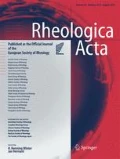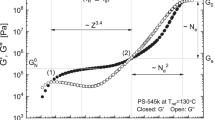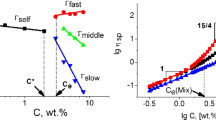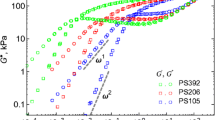Abstract
Viscoelastic properties were examined for semidilute solutions of poly(methyl methacrylate) (PMMA) and polystyrene (PS) in chlorinated biphenyl. The number of entanglement per molecule, N, was evaluated from the plateau modulus, G N . Two time constants, τs and τ1, respectively, characterizing the glass-to-rubber transition and terminal flow regions, were evaluated from the complex modulus and the relaxation modulus. A time constant τ k supposedly characterizing the shrink of an extended chain, was evaluated from the relaxation modulus at finite strains. The ratios τ1/τ s and τ k /τ s were determined solely by N for each polymer species. The ratio τ1/τ s was proportional to N 4.5 and N 3.5 for PMMA and PS solutions, respectively. The ratio τ k /τ s was approximately proportional to N 2.0 in accord with the prediction of the tube model theory, for either of the polymers. However, the values for PMMA were about four times as large as those for PS. The result is contrary to the expectation from the tube model theory that the viscoelasticity of a polymeric system, with given molecular weight and concentration, is determined if two material constants τ s and G N are known.
Similar content being viewed by others
References
Baumgaertel M, Schausberger A, Winter HH (1990) The relaxation of polymers with linear flexible chains of uniform length. Rheol Acta 29:400–408
Baumgaertel M, De Rosa MF, Machado J, Masse M, Winter HH (1992) The relaxation spectrum of nearly monodisperse polybutadiene melts. Rheol Acta 31:75–82
Carella JM, Graessley WW, Fetters LJ (1984) Effect of chain microstructure on the viscoelastic properties of linear polymer melts. Macrom 17:2775–2786
de Gennes PG (1971) Reptation of a polymer chain in the presence of fixed obstacles. J Chem Phys 55:572–579
Doi M, Edwards SF (1978) Dynamics of concentrated polymer systems. J Chem Soc Faraday Trans II 74:1789–1829
Doi M (1980) Molecular rheology of concentrated polymer systems I. J Polym Sci Polym Phys Ed 18:1005–1020
Doi M (1983) Explanation for the 3.4-power law for viscosity of polymeric liquids on the basis of the tube model. J Polym Sci Polym Phys Ed 21:667–684
Ferry JD (1980) Viscoelastic properties of polymers. 3rd ed. Wiley, New York
Gotro JT, Graessley WW (1984) Model hydrocarbon polymers: Rheological properties of linear polyisoprene and hydrogenated polyisoprene. Macrom 17:2267–2275
Graessley WW (1982) Entangled linear, branched and network polymer. Adv Polym Sci 47:67–117
Laun HM (1978) Description of the nonlinear shear behavior of a linear low density polyethylene melt by an experimentally determined strain dependent memory function. Rheol Acta 17:1–15
Masuda T, Kitagawa K, Onogi S (1970) Viscoelastic properties of poly(methyl methacrylate)s prepared by anionic polymerization. Polym J 1:418–424
Masuda T, Toda N, Aoto Y, Onogi S (1972) Viscoelastic properties of concentrated solutions of poly(methyl methacrylate) in diethyl phthalate. Polym J 3:315–321
Onogi S, Masuda T, Ibaragi T (1968) Rheological properties of polymethyl methacrylate and polyvinyl acetate in the molten state. Kolloid-Z & Z fur Polym 222:110–124
Osaki K, Kurata M (1980) Experimental appraisal of DoiEdwards theory for polymer rheology based on the data for polystyrene solutions. Macrom 13:671–676
Osaki K, Doi M (1984) Nonlinear viscoelasticity of concentrated polymer systems. Polym Eng Rev 4:35–72
Osaki K, Nishimura Y, Kurata M (1985) Viscoelastic properties of semidilute polystyrene solutions. Macrom 18: 1153–1157
Osaki K, Takatori E, Tsunashima Y, Kurata M (1987) On the universality of viscoelastic properties of polymeric systems. Macrom 20:525–529
Raju VR, Menezes EV, Marin G, Graessley WW, Fetters LJ (1981) Concentration and molecular weight dependence of viscoelastic properties of linear and star polymers. Macrom 14:1668–1676
Rouse PE (1953) A theory of linear viscoelastic properties of dilute solutions of coiling polymers. J Chem Phys 21:1272–1280
Tamura M, Kurata M, Osaki K, Einaga Y, Kimura S (1971) A new type of apparatus for stress relaxation measurement under large strain. Bull Inst Chem Res Kyoto Univ 49:43–52
Vrentas CM, Graessley WW (1981) Relaxation of shear and normal stress components in step-strain experiments. J Non-Newtonian Fluid Mech 9:339–355
Vrentas CM, Graessley WW (1982) Study of shear stress relaxation in well-characterized polymer liquids. J Rheol 26:359–371
Wendel H, Noolandi J (1982) Generalized reptation model. Macrom 15:1318–1320
Author information
Authors and Affiliations
Rights and permissions
About this article
Cite this article
Osaki, K., Takatori, E., Watanabe, H. et al. Viscoelastic properties of semidilute poly(methyl methacrylate) solutions. Rheola Acta 32, 132–139 (1993). https://doi.org/10.1007/BF00366676
Received:
Issue Date:
DOI: https://doi.org/10.1007/BF00366676




